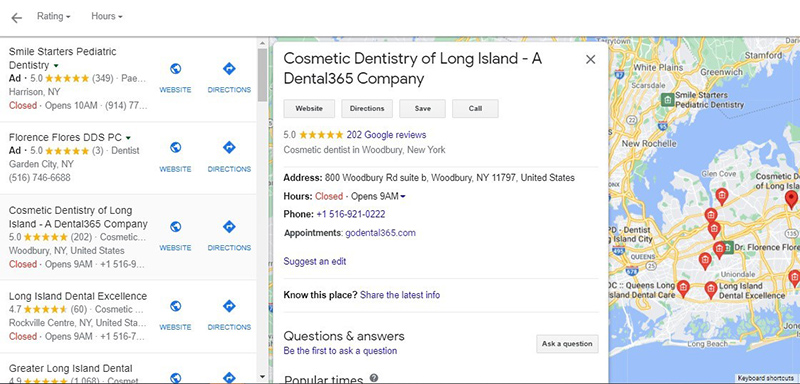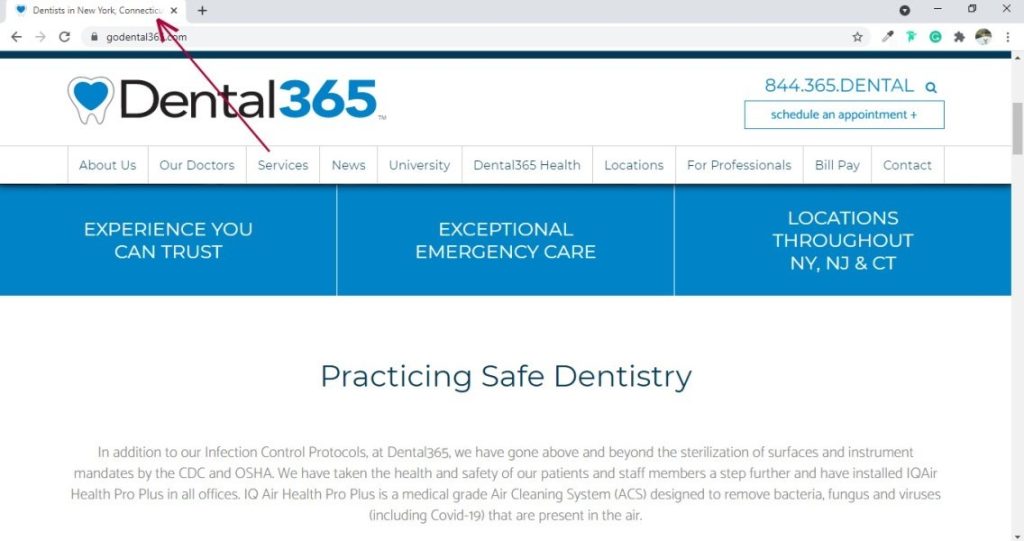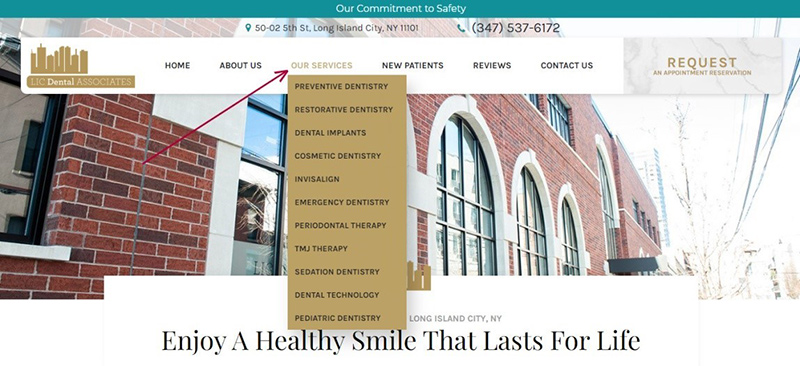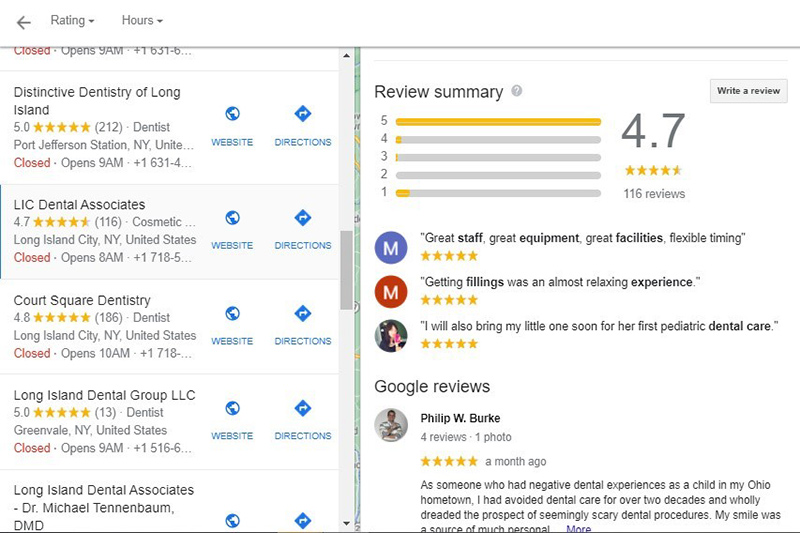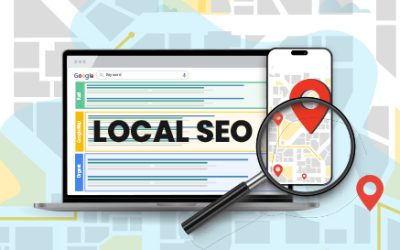According to SEO Tribunal, 97% of people utilize search engines these days to find out about local businesses. Dentists are now investing in local SEO with the goal of attracting new local potential patients to their clinic. By implementing effective local SEO strategies, dental practices can position themselves prominently in the search engine search results. This boosts their chances of getting noticed by local patients. Reliable local SEO services can help increase your organic visibility and targeted traffic, and grow your practice.
Why is Local SEO Important for Dentists? Local SEO concentrates on raising your ranking in local search engine results pages (SERPs). While standard SEO boosts your visibility on a larger scale, local SEO focuses on attracting patients in your locality. Google’s algorithms, which contain over 200 ranking factors—many of which Google has not revealed—determine your visibility in local search engine results pages. Google gives relevance, quality, and usability the highest priority when ranking pages. This implies that, to gain local visibility, creating high-quality content that aligns with visitors’ search intent should be your main priority. According to SEO Tribunal, 72% of customers will visit a store within five miles of their area after searching Google for local companies. With well-implemented local SEO, your practice will benefit from higher ranking and enhanced local visibility, potentially attracting more visitors to your website and ultimately, your dental practice. Local SEO is the best SEO technique for dentists since it displays results faster than conventional SEO and has less competition for ranks because of regional criteria.
Top Local SEO Strategies for Dentists
Here are some effective local SEO strategies for dentists:
- Research Keywords for SEO: The first step of any local SEO strategy is keyword research. Keywords are the words that people use to conduct searches. For dentists, the keyword list may include words like “teeth scaling,” “polishing,” “crowning,” “teeth whitening” etc. Using relevant keywords in your website content is essential to gain traffic. Tools like Keyword Planner can help identify relevant keywords that the visitors use to search for your products/services online. Keywords can be hiring intent keywords or research intent keywords.
-
- Hiring intent keywords are keywords that encourage users to take action. For example, keywords like “teeth scaling dentist”, “dentist near me” are some of the keywords that people use when they are looking for a dentist. They are likely to click on the links that appear at the top of the search engine results. Hiring intent keywords should be used to optimize your home page and website. If your objective is a better ranking, then focus on hiring intent keywords.
- Research intent keyword: Research intent keywords play a secondary role in SEO and are best suitable for FAQ pages. For example, keywords like “good oral hygiene”, “DIY teeth whitening” etc can be used for blog posts.
So, the key here is to use hiring intent keywords for home pages and services pages, and research intent keywords for informative pages.
- Optimize Your Website for Google Business Profile Page: Google Business Profile (GBP) helps you to list your practice’s location on Google Maps and local search results. So, optimizing your Google My Business profile is important for SEO initiatives to give a compelling introduction of your practice to attract patients. Having a Google Business Profile also helps to improve your website ranking because Google shows GBP map page on top of the search results. So, here are some tips to optimize your GBP profile.
-
- Verify your page: Make sure to get your page verified with Google. You will find a checkmark with the word “Verified” next to your business, when you get verified. If your GMB profile is not verified, then click on “Verify Now” on your dashboard. If you have more than one GMB page, merge them.
- Give NAP information: NAP refers to Name, Address and Phone number. Make sure to provide the right information so that Google Maps can locate your practice. When you give your phone number, provide the local number to strengthen your presence as a local business. Ensure that your Name, Address and Phone number are accurate and consistent across your Google My Business page and directory listings.
-
- Description: This is a space where you can introduce your dental practice to potential patients. Descriptions should be very well-written with the correct spelling. Use simple language in a conversational tone so that potential patients can understand easily. Include relevant keywords into your description so that Google can easily find you.
- Working hours: The working hours of your dental practice, namely morning hours and evening hours, should be accurately mentioned so that the patients can choose the correct time to come to your practice.
- Images: Images of your practice help to improve engagement with your patients. It also helps the patients to find your location and know more about your business.
- Categories: According to Google’s guidelines, each category should describe what your practice is and what it does. Some of the categories for dentists are: Cosmetic dentists, Dental Clinic, Emergency Dental Service etc. Pick at least 3 to 5 categories.
- Optimize Your Website: Optimizing your website refers to making necessary edits to your core pages to attract prospective patients. So, make sure to use hiring intent keywords.
-
- Home page: The Home page is the most important page on a website, and the key element that should be optimized on the home page is your title tag. Title tags appear at the top of the web browser and the text in the blue underlined link in Google’s search results.
-
- Title tags are similar to chapter titles in a book, so optimize them for your primary keyword. Primary keywords are those keywords that users commonly use for online search when they are looking for a dentist in your area like “Dentist in New York” or “Dentist in Michigan”. Brainstorm a list of keywords and check them using tools like Google’s Keyword Planner to ensure that the keywords that you have chosen are keywords that prospective patients use to conduct searches. Knowing how to write a title tag is also important to get more patients to your website. The title tag format is Dentist in {Your City} | {Name of Your Practice}. For example, if you are a dentist in New York and your organization’s name is “Brooklyn Dental Care”, then your title tag will be Dentist in NYC | Brooklyn Dental Care. The characters in your title tag should be between 50 and 65. Once your title tag is done, the next thing is meta descriptions for your home page. Meta description is the text that Google shows below the blue underlined link in the search results. Let us consider the image below
- The highlighted text in the image is the meta description. It may also include the name of the practice, and the phone number to schedule the appointment. The meta description should be 100 to 150 characters. Similar to meta description, headlines of the page are also important, also known as H1. It should include a relevant keyword. For example, {Type of Dentistry} in {City, State} as in General & Cosmetic Dentistry in NYC.The last element is a website copy on your homepage that consists of a minimum 200 words of copy. It should provide background information about your practice. Make sure to include a keyword in it.
- Service page: Having a single service page that lists all the services you provide with a brief description is not enough. Set up separate service pages for each of your services with detailed information and this helps in ranking. For example, if you provide cosmetic dentistry and orthodontic treatment, set up different pages for both the services. You can also have subpages for each of these services. All service pages should be optimized with relevant keywords along with title tag, meta description, header (H1) and body copy.
-
- Content page: Once your core pages like service page and home page are optimized, the next one is content page. Perform a keyword research using Google’s Keyword Planner to find out the relevant topics for content. For example, if you provide orthodontics treatment then, you can create content about “affordable orthodontics treatment for adults”. Apart from blogs, you can also develop content pages like FAQ sections. Think of possible questions that prospective patients may ask. You can answer these questions and then create a page for each question-and-answer, linked from your main FAQ page. Make sure to optimize your content page also to get more traffic.
If you wish to enhance your content for your local audience then you can, read our blog on Diverse Content Strategies for Enhancing local seo success
- Focus on the User Experience (UX): A strong user experience (UX) is essential since Google gives a lot of weight to UX in local search rankings. Create content pages based on pertinent, commonly asked topics found on Google to begin enhancing user experience. Responding to inquiries from patients on a FAQ page makes you more relevant and helpful to searches. Don’t forget to create quality content! Leveraging social media and blogging can boost your visibility and credibility in your community.
- Build Links and Citations: After optimizing your website and Google My Business page, the next step is building links and citations.Citations are mentions of your practice Name, Address and Phone number and citations should be included on your website, contact page and also on the footer of your website. You can build your citation by getting listed on relevant directories like Google My Business or Yelp. The following are 3 main categories of directories where you should rank higher.
- General, National Business Directories: The best place to begin is by getting listed on general business directories like Yelp.com, YellowPages etc.
- Local Directories: Get listed on local business directories and ensure that your NAP information is consistent and accurate across all directories.
- Industry-specific Directories: For dentists, getting listed on industry-specific directories like everydentist.com and implantdirectory.com is important. There may be free and paid directories. Focus on free directories first, but if you move to paid directories, then make sure to generate some website referral traffic from those directories.
- Building links: These are also known as inbound links and Google emphasizes link building. The more links you have, the higher will be your website’s authority and relevance. This will also help increase your ranking.
- Directories: Getting listed in local directories is useful for Local SEO, and it is a source for getting citations and links.
- Competitor research: Find out which websites link to your competitors by checking your competitors in a tool like Moz Open Site Explorer. This may also give your additional information about your competitors.
- Offline relationship: Look into the offline relationships you have established, and find out if you can obtain links from those entities. In case you already have a referral relationship with other medical professionals, consider linking to each other as recommended resources on your individual websites. If you are a member of an association, you could gain a link in that directory listing. If you have sponsored a local event, you could gain a link as part of your sponsorship.
- Analyze your Online Reviews: Reviews from your patients are important for local SEO and improve ranking.
-
- Concentrate on Google My Business: Getting good reviews on your GMB page helps with improving ranking, and it also increases your visibility. When potential patients see good reviews about your dental practice, they are likely to contact you or visit your clinic.
-
- How to get reviews: You may either send a review request through email, or send a link to review your service on Google My Business. To find your GMB page, you can Google your practice name and location and your GMB page will appear. You can request your patients to find your GMB page and leave a star rating, and also leave a review.
- Track your SEO Efforts: Once all your local SEO efforts are done, it is important to keep track of these changes and find out which techniques are working and which measures are not working. Here are 3 metrics that you should track:
- Ranking: Check your ranking once or twice a month using Google Search Console. This will help you to see which keywords are ranking better in Google, and also know how many clicks each keyword offers. You can use paid tools like Rank ranger to update your ranking reports.
- Traffic: Traffic refers to the number of visitors on your website. The best way to monitor traffic is by using Google Analytics. Log in to Google Analytics to know how much traffic you are getting, how much traffic you’re receiving from Google, and which pages are receiving the most traffic. Review your traffic once in a month to know how your SEO traffic is growing.
- Conversion: Once your ranking and traffic are optimized, the next step is to monitor your conversion. Conversion refers to a specific action you want your website visitors to take. For example, clicking on “Schedule an Appointment” is the desired action you want your prospective patients to take. Tracking your conversion rate is important to find out how many new patients are coming from your local SEO marketing efforts.
Call us at (800) 941-5527 to give your medical practice the visibility it deserves
Expertise in local search engine optimization is essential for dentists who want to succeed in their areas. Applying these strategies can create a strong basis for increased awareness, improved patient confidence, and a successful practice. Using local SEO services is the best way to create a strong online presence, leave a lasting impression on your local audience, and attract more patients to your practice.


